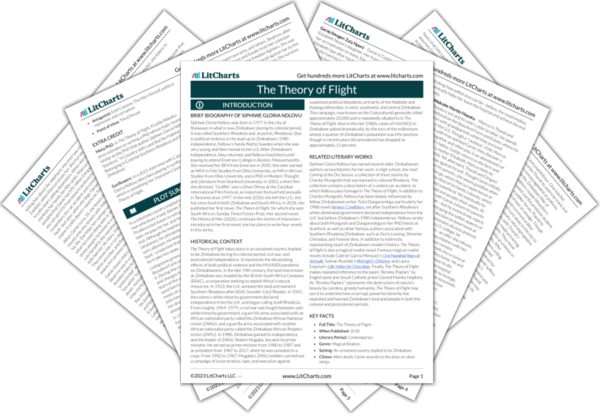The Theory of Flight never names the country where most of its events take place, but context clues indicate the country is Zimbabwe, which was occupied by British companies in the late 19th century and officially annexed as Southern Rhodesia by the U.K. in 1923. In 1965, the white minority that ruled Southern Rhodesia declared independence from the U.K., which triggered a civil war between said rulers and indigenous African political parties. In early 1980, after extended conflict, Robert Mugabe of the Zimbabwe African National Union was voted the nation’s Prime Minister, and Prince Charles of the U.K. ceremonially granted Zimbabwe its independence. Though one might suppose that Zimbabwe’s colonial and postcolonial eras would be radically different, The Theory of Flight depicts them as fundamentally similar, with violent, oppressive governments destroying ordinary Zimbabweans’ lives. The novel insists most forcefully on the continuity between Zimbabwe’s colonial and postcolonial eras with the characters of Emil Coetzee and The Man Himself. In the colonial era, Emil Coetzee, who works for the white minority government, founds a surveillance group called The Organization of Domestic Affairs that oppresses the indigenous African population, arresting and incarcerating any African people perceived as threats to the government. During the transfer from colonial rule to the postcolonial government, Emil Coetzee dies by suicide—but he lives on in The Man Himself, presumably a stand-in for Robert Mugabe, who takes over Emil Coetzee’s offices, tweaks the name of The Organization of Domestic Affairs (now just “The Organization”), and otherwise continues to terrorize and murder perceived political enemies, including ethnic minorities and former revolutionary heroes. Thus the novel suggests that to truly end colonialism, it would be necessary not only to get rid of the colonizers, but to reject the violent, hierarchical strategies of government control the colonizers put in place.
Colonialism and Postcolonialism ThemeTracker

Colonialism and Postcolonialism Quotes in The Theory of Flight
Well, Marcus Malcolm Martin Masuku, you can be friends with my Genie here if you promise me one thing. Can you promise me one thing? […] Promise me that you will not become a politician . . . promise me you will become a real revolutionary instead.
So engrossed were they in their travels that it took them a while to notice that shoots were beginning to rise out of the reddish-brown earth. The sunflowers were being reborn. This was how they learned their most valuable lesson about death—that after it there is life again, that things that perish will rise again, that after every ending there is another beginning.
The Man Himself told Bhekithemba that because the country was still young and working out its differences, and because civil wars often had repercussions, conflict was inevitable. However, the country had an image to portray and protect, and Western countries were waiting for it to fail. It was Bhekithemba’s job to ensure that the West did not receive any ammunition with which to destroy the country’s image.
“There was a time, not so long ago, that we thought only white people capable of such hatred and anger, such evil. We know better now. Evil does not discriminate. It visits all of us with equal opportunity.”
The past ten years have had her talking about “them” more and more. Kuki does not want to be misunderstood. She is not a racist. She does not have a racist bone in her body. She is a liberal; has been ever since she married Todd Whitehead Carmichael in 1981. So no, she is not a racist. She is just a frustrated liberal.
[…]
They always seem so nice and friendly, but they are really wolves in sheep’s clothing . . . and if you give them an inch they will run the country into the ground and let it go to the dogs.
In a house filled with the proud collections and clutter of Jakob de Villiers’s life, Blue’s absence seems like a haunting.
“We live in a time of HIV and AIDS,” Bhekithemba continues. “Everyone knows someone in [the] hospital who is fighting to survive. That fact alone—that we all know someone who is struggling to be alive—should be the headline every day, but it is not. It is our reality, the way we live now, our truth. So of course we cannot acknowledge it, let alone print it.”
As they gang-raped, shot and pillaged their way through the compound, they had also, unbeknownst to themselves, found another way to decimate the compound. It did not have to be all of them who carried the disease. Just one—the result would have been the same.
And now to find out that Genie too . . .











